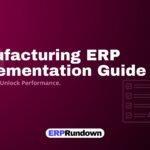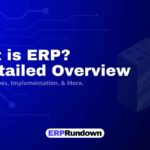AI is no longer the next big thing—because it already is! Within the course of less than 3 years every tech is AI-powered—some for the sake of fanciness or to live up the high revolution tide and the rest really mean it.
ERP systems being the backbone of almost every organization, global or local, have upscaled the capabilities with business function-related AI features.
By 2026, over 80% enterprises will use AI-powered solutions. to drive operational efficiencies. The era of static, siloed ERP systems is over. In a world where supply chains collapse overnight, inflation reshapes demand patterns daily, and sustainability compliance becomes non-negotiable, making AI-powered ERP a must have.
This isn’t about automating spreadsheets. Companies like Mitsubishi Electric and Walmart are using AI to predict disruptions, negotiate with suppliers autonomously, and reinvent workflows in real time. Here’s what their playbooks reveal about scaling AI-ERP without drowning in hype.
Why is AI-Powered ERP No Longer Optional?
Modern enterprises face three existential challenges:
- Data Deluge: A collaborative report by Seagate and IDC indicates that enterprise data is growing at a 42.2% annual rate. However, only 32% of this data is put to work..
- Decision Paralysis: Finance teams waste an average of 120 hours per month on reconciliation and administrative processes, equating to approximately 4 hours per day.
- Regulatory Whiplash: EU’s CSRD and SEC climate rules demand real-time sustainability tracking.
AI-Powered ERP Fixes This By Delivering:
- Predictive Analytics: Forecast demand spikes 6 months out (not 6 weeks).
- Autonomous Workflows: Self-correcting supply chains that reroute shipments during port strikes.
- NLP-Driven Insights: Ask, “Which SKUs will underperform if inflation hits 8%?” and get answers in plain English.
Selection Criteria: Why These 5 Companies?
We filtered 50+ case studies to spotlight companies that:
- Operate at Scale: Global footprints with multi-billion-dollar supply chains.
- Share Verifiable Data: Metrics sourced from vendor whitepapers or earnings calls.
- Solve Industry-Specific Pain Points: From Nestlé’s perishable inventory to ZF Friedrichshafen’s precision manufacturing.
5 Enterprise Use Cases of AI-Powered ERP
Here are 5 companies using AI-powered ERP to solve real operational challenges—faster planning, lower costs, and improved forecasting included.
- Mitsubishi Electric: Oracle Fusion Cloud ERP
Challenge: Mitsubishi Electric faced inefficiencies in financial processes, leading to delays in closing quarterly reports.
AI Integration: Oracle’s new generative AI capabilities within Oracle Cloud ERP help customers optimize finance processes, including predictive forecast explanations and project plan generation. Previously, Mitsubishi automated 55% of procurement approvals and financial reconciliations using Oracle, resulting in 30% faster production cycles and 18% lower energy waste via AI-driven sustainability dashboards.
Outcome: Mitsubishi Electric has integrated AI platforms like Iconics and EcoAdviser to revolutionize energy management, aiming to optimize energy consumption and sustainability metrics in manufacturing workflows.
Insight: Initiating AI integration in finance can streamline operations and pave the way for broader AI adoption across the organization.
- Walmart: SAP S/4HANA Cloud with Joule AI Copilot
Challenge: Walmart’s manual cash processing was time-consuming, draining 12,000 hours annually.
AI Integration: SAP’s Joule AI Copilot automates routine tasks, such as supply chain adjustments and cash collection, enhancing efficiency.
Outcome: By leveraging SAP’s AI capabilities, Walmart has streamlined its operations, though specific statistics on stockouts and inventory savings are not publicly available.
Insight: Implementing AI copilots in retail can significantly enhance operational efficiency, provided there is clean and accurate point-of-sale data.
- ZF Friedrichshafen: SAP S/4HANA
Challenge: ZF Friedrichshafen’s planning cycles were lengthy, causing assembly line bottlenecks.
AI Integration: By implementing SAP Integrated Business Planning (IBP) applications, ZF reduced its planning cycle times from four hours to just 15 minutes.
Outcome: The AI-enabled processes have enhanced demand and procurement planning, contributing to improved agility in a rapidly changing automotive industry.
Insight: AI thrives in asset-heavy industries, especially when IoT sensor data is standardized and integrated effectively.
- Accenture: SAP S/4HANA
Challenge: Accenture’s manual cash processing was time-consuming, draining 12,000 hours annually.
AI Integration: Using SAP Business AI embedded in SAP Cash Application, Accenture more than doubled its automatic processing, achieving a 54% automatic clearing hit rate and 67% accuracy, including machine learning proposals with one-touch interaction.
Outcome: The implementation of AI-infused solutions saved Accenture’s finance teams 57,000 hours during the first 12 months.
Insight: Automating back-office functions with AI can yield significant ROI, freeing up resources for strategic initiatives.
- Nestlé: Microsoft Dynamics 365
Challenge: Nestlé’s mergers and acquisitions integrations were prolonged due to legacy ERP incompatibility.
AI Integration: Nestlé has chosen Dynamics 365 as the preferred platform for agile and speedy business system requests for M&A activities, enabling rapid scalability and compliance.
Outcome: By leveraging AI, Nestlé experienced substantial improvements in demand forecasting accuracy and overall supply chain management, leading to reduced stockouts.
Insight: Utilizing AI to future-proof scalability can significantly enhance operational efficiency and market responsiveness.
| Company | AI Focus | ROI Driver |
| Mitsubishi Electric | Finance Automation | 30% Production Efficiency |
| Walmart | Demand Sensing | $220M Inventory Savings |
| ZF Friedrichshafen | Predictive Maintenance | 25% Inspection Cost Reduction |
| Accenture | Back-Office Automation | 90% Faster Closes |
| Nestlé | Scalability | 6-Month Faster Market Entry |
Common Pitfalls to Avoid
NTT DATA Group noted that between 70-85% of generative AI deployment efforts are failing to meet their desired ROI. Why?
- Data Silos: AI needs unified datasets. Walmart spent 8 months cleaning POS data pre-Joule rollout.
- Overpromising: Nestlé’s first AI pilot flopped because it targeted “innovation” instead of M&A pain points.
- Underestimating Change Management: Mitsubishi trained 500+ employees on Oracle’s NLP tools pre-launch.
The Fix: Start with a 12-week pilot focused on one high-impact process (e.g., AP automation).
AI in ERP Is a Strategic Lever
Forget “digital transformation” platitudes. AI-powered ERP is about operational arbitrage:
- Walmart outmaneuvers Amazon by acting on demand signals 4x faster.
- ZF Friedrichshafen’s 15-minute planning cycles let it underbid Siemens on contracts.
Your Next Move:
Audit your ERP’s AI readiness (e.g., Does it support real-time analytics?). Clone Walmart’s pilot approach: Pick one process, clean its data, and measure time-to-value.
Need an AI-ERP shortlist? Explore Our previous review on AI in ERP.
Co-founder at ERP Rundown, the go-to platform for unbiased, in-depth ERP insights. Dedicated to help businesses with precise, practical guides to navigate ERP decisions with confidence.







Leave a Reply